 At the end of another week in Tonga, the weather is crappy again. Winds are at over 30 knots, the sky is grey, and the air feels heavy...as if storms are just over the horizon.
At the end of another week in Tonga, the weather is crappy again. Winds are at over 30 knots, the sky is grey, and the air feels heavy...as if storms are just over the horizon.
It's a stark contrast to the start of the week, when the strong winds that have been plaguing us all season suddenly disappeared, and we awoke to a harbour that was a still as the surface of a mountain lake.
The air was light and crisp, the sun bright and overall mood one of expectation and endless possibilities.
A Very Special Morning
So it was on the first day out this week. We set out early, and within minutes of leaving the harbour I found a mother, calf and escort in the main channel. As I've pointed out previously, calfs have been relatively scarce this season, so it was nice to find one so quickly, especially on the first day out with a new group of visitors from Japan.
As usual, we spent some time observing the whales' behaviour in order to assess their mood and determine the appropriate course of action. The trio were being somewhat circumspect, and I started to think that it might be best to leave them alone.
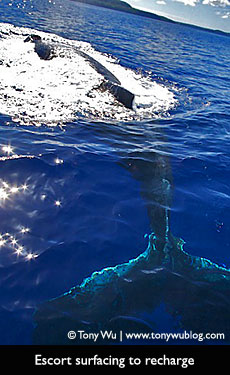 Gauging the mood of whales isn't easy. There's no straightforward yardstick by which to measure their reactions, nor is there any set of accurate rules or guidelines that spell out the proper formula in black and white...more on this point in a bit.
Gauging the mood of whales isn't easy. There's no straightforward yardstick by which to measure their reactions, nor is there any set of accurate rules or guidelines that spell out the proper formula in black and white...more on this point in a bit.
As I leaned over to have a chat with the captain, the reason for the trio's wariness became all too clear. Two other whales...wannabee escorts...appeared suddenly and violently on the scene, frothing up the water and issuing an ultimatum to the existing escort..."Stand your ground, or pass her over to us!"
In the blink of an eye, the previously calm mood of the morning transformed into an energetic battle among leviathans for superiority and the right to mate. Totally cool.
I jumped up to let everyone know what was happening, and informed them that we wouldn't be getting into the water for a while at least. It was time to get the topside cameras out, enjoy our ringside seats and watch the epic struggle unfold.
 With five whales involved (mom, baby, original escort, two upstart challengers), the pace escalated rapidly. Spouts appeared to our left, then right, front, back...all over. Footprints popped up everywhere. Large, horny males swam under our boat, swishing their tails at one another and sending enormous eddies across the channel.
With five whales involved (mom, baby, original escort, two upstart challengers), the pace escalated rapidly. Spouts appeared to our left, then right, front, back...all over. Footprints popped up everywhere. Large, horny males swam under our boat, swishing their tails at one another and sending enormous eddies across the channel.
With the surface of the water completely calm, we were able to look straight down into the water and watch as the males clashed, then surfaced abruptly within arm's reach with loud grunts and snorts...sending bubbles and large sprays of water upward as they expelled spent air, inhaled and dived quickly to continue their epic struggle.
Mom and baby, possibly trying to stay out of the way as the boys got on with their boy stuff, continued to swim rapidly, quite often doubling back on their path, as if trying to shake the rowdy males.
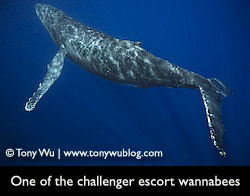 Baby whales can't stay submerged as long as adults, so the little one came up for air more often than the others...the teeny "pfffff" sound from it's diminutive breaths quite often drowned out by the loud groans and tortured breaths of the larger whales locked in conflict.
Baby whales can't stay submerged as long as adults, so the little one came up for air more often than the others...the teeny "pfffff" sound from it's diminutive breaths quite often drowned out by the loud groans and tortured breaths of the larger whales locked in conflict.
As the battle ensued, their came a point at which everyone seemed to need a rest. The action slowed, and the whales seemed to have reached a mutual, if temporary, accord, agreeing to hang out together for a little while as everyone recovered for round two.
Grabbing this opportunity, I got everyone into the water for a quick look. The original escort plus the mom and baby swam by first, not seeming to mind our presence, but not really stopping for a look...perfectly understandable given the circumstances.
As the original trio approached, the baby began to feed. From its normal position near mommy's head, the little calf swam toward the rear and underside of the large female, where the mammary slits are located, and began to suckle.
Though I've witnessed this behaviour many times before, I couldn't believe my eyes, as the mom and baby were swimming directly toward me. Usually, feeding takes place somewhat deep down, within sight but out of reasonable camera range, so I haven't been able to get decent photographs of this mother/ calf interaction...until now.
 As I watched mom and newborn swim by and clicked off a few frames, the escort suddenly did a 360-degree loop, like a fighter plane executing a battle manoeveur. Watching 50+ tonnes execute a pinpoint turn at high speed like that was an awesome sight, and could have meant only one thing...an official end to detente. The other two would-be escorts appeared suddenly from the deep, and the battle was on again.
As I watched mom and newborn swim by and clicked off a few frames, the escort suddenly did a 360-degree loop, like a fighter plane executing a battle manoeveur. Watching 50+ tonnes execute a pinpoint turn at high speed like that was an awesome sight, and could have meant only one thing...an official end to detente. The other two would-be escorts appeared suddenly from the deep, and the battle was on again.
Back on the boat, we continued to watch for another two hours, until finally, the action stopped as suddenly as it had begun. When the proverbial dust had settled, only the original escort remained. Clearly, he had proven his merit and driven off the unsuccessful usurpers, despite the lopsided odds.
We didn't see where the other two went, but no doubt the despondent pair went off to nurse their wounded pride, rethink their strategy and look for other potential mates.
What Whales Want
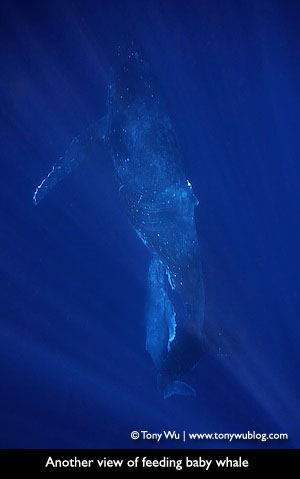 As I mentioned above, it's not easy interpreting what whales (or any other wild animals) are thinking, feeling or about to do. Even with years of experience, it's easy to misread the tea leaves. I like to think that I know the humpbacks here, and generally, I can foresee what's likely to happen.
As I mentioned above, it's not easy interpreting what whales (or any other wild animals) are thinking, feeling or about to do. Even with years of experience, it's easy to misread the tea leaves. I like to think that I know the humpbacks here, and generally, I can foresee what's likely to happen.
But (and this is an important "but"), I always keep in mind that these are wild animals, not pets, circus animals, or amusement-park attractions. Their behaviour is inherently unpredictable, and forecasting humpback mood is a tenuous art at best.
Which is why it boggles my mind how many people who've never been in the water with whales, or who may have spent just a few days here, suddenly become self-appointed "experts" about whales. Inevitably, I run into people who definitively "know" when a whale is happy or otherwise.
This topic quite often comes up in the context of someone who decides that someone else has been "harassing" whales, a charge most often levelled in a highly indignant tone by people who have a sum total of 30 seconds of experience with whales.
With the whales above, for example, it would have been easy for an uniformed person observing from a distance to mis-conclude that our boat had "harassed" whales. Why? Because there were very calm whales near us one moment...then suddenly all hell broke loose.
Many people believe that whales and other cetaceans are highly intelligent, highly evolved, peaceful beings that smile and play all day, ready at a moment's notice to rescue humans in distress. They are certainly intelligent, but wild cetaceans are nothing like the captive dolphins in Sea World, TV programs and such.
I blame the mass popular media for perpetuating the "Flipper" myth and conveying an endearing but entirely false image of cetaceans. In real life, cetaceans exhibit a full range of behaviour and moods...from playing nice to beating the cr*p out of each other, and everything in between.
Within this context, it's easy for people with nothing but a TV drama-inspired understanding of cetaceans to conclude that whales only act-up when people harass them. Nothing could be further from the truth. Whales, like most animals, act up for all sorts of reasons, most of which make complete sense if you stop to think about it. Most importantly, they act up irrespective of whether people are around or not. We're irrelevant.
 Fortunately, there was no misunderstanding related to the encounter described above, but I have witnessed many misunderstandings before. In one particularly egregious incident a few years ago, somehow or another, a boatload of tourists had been intentionally misinformed by their boat operator and/ or tour organiser that whales only breach when they're being harassed. The end result was a bunch of distraught tourists who thought every time a whale breached, some boat was harassing the poor animal. They went around picking fights with anyone in a boat with breaching whales nearby.
Fortunately, there was no misunderstanding related to the encounter described above, but I have witnessed many misunderstandings before. In one particularly egregious incident a few years ago, somehow or another, a boatload of tourists had been intentionally misinformed by their boat operator and/ or tour organiser that whales only breach when they're being harassed. The end result was a bunch of distraught tourists who thought every time a whale breached, some boat was harassing the poor animal. They went around picking fights with anyone in a boat with breaching whales nearby.
Aiyah, how stupid.
If there's one thing I've learned over many years of interacting with whales and other wild cetaceans is that many of the crises that these marine mammals allegedly face are manufactured in the minds and imaginations of well-meaning but ignorant people...emotions taking precedence over reality.
If you ever have the opportunity to interact with cetaceans, try to maintain proper perspective and get the facts first. Whales and dolphins do things for reasons we sometimes understand, but more often than not, we don't have a clue what's going on, and play no role at all in what happens.
Calf Roster Additions
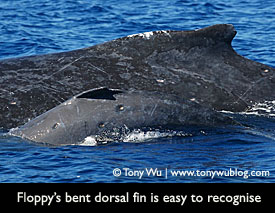 In recent days, it seems as if the number of calves has started to increase. We're up to 12 confirmed calfs, with another 1-2 possible. The babies we ID-ed this week include:
In recent days, it seems as if the number of calves has started to increase. We're up to 12 confirmed calfs, with another 1-2 possible. The babies we ID-ed this week include:
Jewel (#7) has a distinctive diamond-shaped pattern on the posterior left torso, almost exactly in the shape of the Southern Cross, but made up of scars left behind by cookie-cutter shark bites. Jewel's mom is mostly black and very shy. I found her with an escort one day. Takaji got her without the escort on the next day.
Kenshiro (#8) has lots and lots of little round scars from cookie-cutter sharks. Kenshiro is a Japanese manga character with lots of holes (I don't know the character, but everyone else around me does)
Floppy (#9) is the calf in the story above, who has a distinctive bent-over, floppy dorsal fin. More on Floppy below.
McQueen (#10) has nearly all-white pecs (making it the 3rd whale this season we've spotted, and the only baby we've ever spotted with this distinctive trait). Perhaps it's the offspring of one of the many all-white pec whales I saw last season? McQueen is the main character in the movie Cars, which is a favourite of one of Takaji's kids.
White Spot (#11) has a very distinct white scar on the left anterior torso, and both White Spot and mom have dozens of remoras travelling with them. Some whales have lots of remoras, most don't have any or few at all. How remoras decide which whales to tag along with, I don't think anyone knows.
Oscar (#12) is really easy to spot. On the left front side of its dorsal fin, there's an easily recognisable circular mark, perhaps a birth mark, with a scar running through it. "O" + "scar" = Oscar. Very, very shy mother.
Between Takaji and me, we have photos and/ or video of all of these. I don't have time to organise them now, but I'm going to endeavour to put together a summary once I'm back. In fact, we're going to try to put together a summary each season from now on, since there doesn't seem to be anyone else doing this.
Other Whale Stuff
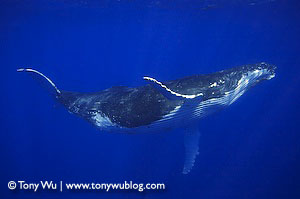 During the balance of the week, there was one day that just sucked...with nearly no whales around at all, and others that were action--packed from the get-go. Over the years, I've noticed that the whales seem to have "moods", for lack of a better word. It seems as if a significant proportion of the whale population gets into the same mood at the same time.
During the balance of the week, there was one day that just sucked...with nearly no whales around at all, and others that were action--packed from the get-go. Over the years, I've noticed that the whales seem to have "moods", for lack of a better word. It seems as if a significant proportion of the whale population gets into the same mood at the same time.
What this means is that when the whales decide to hang around the islands and play, they seem to do it in large numbers. When they decide to go far offshore and do whatever it is they do..."poof", they're all gone at the same time. When they sing, lots of them sing. When they rest, they all seem to rest.
This is a purely "anecdoctal" observation, as researchers would say, as I have no methodical data to back this up, but it's consistent enough that I'm quite certain there's something behind it.
Actually, if you stop to think about it, this makes sense. The whales are social animals, and they're here for a specific purpose...to give birth and raise young, find new partners and mate. They pretty much need to be in sync in order to make the most of their time here.
Among the highlights of the week were a great encounter with a singer, which I was able to find twice at a depth of about 15 metres. The visibility wasn't terrific, but with the sun directly overhead, everyone got into the water and had a clear view of the singer hanging head-down. The loud whoops and melodies of the singer's tune resonated through our bodies, giving everyone a thrill.
 Actually, the story behind the singer is much more involved. In summary, early one morning (with very strong winds and choppy conditions) I spotted two whales together. Given the rough conditions, I was grateful to find anything. We followed for a bit, and soon the two became three, then five, six, eight...until the proceedings evolved into a full-blown heat run.
Actually, the story behind the singer is much more involved. In summary, early one morning (with very strong winds and choppy conditions) I spotted two whales together. Given the rough conditions, I was grateful to find anything. We followed for a bit, and soon the two became three, then five, six, eight...until the proceedings evolved into a full-blown heat run.
With so many whales in the game, the escalating swarm soon split into two. We called another boat over to follow one group, while we continued with another. Unfortunately, our group of six or so headed into open ocean, where conditions were really rough. Just as we were thinking of turning back, a mother and calf breached simultaneously a few hundred metres ahead of us...so we dropped the heat run and headed for the mother and babe.
They continued to breach for a while, but given the difficult conditions, by the time we reached them, they'd stopped their surface play, and had reverted to high-speed travel mode. Without any hope of keeping up with them, we abandoned the effort, and headed back to relatively calm waters...thinking that we'd lost all the whales.
As it turned out, the second group (being followed by the other boat we'd called over) had gone into one of the channels, then split up into solo whales and pairs. Many of them started to sing. My singer was one of these. It took over an hour to track it down, but once I found it, I didn't have any problems keeping tabs on its movements.
Altogether, I spotted at least five singers in the area, perhaps all from the group we'd been following in the morning. Later in the day, as I swam along with the singer (this is much harder than it sounds!) while it transitioned from singing to ascending for a breath, I felt a collective change in mood of the whales in the vicinity.
Jumping back on the boat, I told everyone that I thought singing time was up, and something was about to happen. About 15 minutes later, we saw two blows, then three, five, eight, nine...a new heat run had formed, comprising many of the same whales we'd followed some six hours earlier.
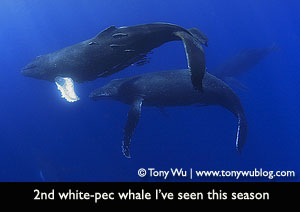 It was great to witness an entire cycle of aggregation to a heat run, dispersing to singing and resting pairs, then re-aggregation to a heat run. It's one thing to explain these things to friends who tag along with me, but there's nothing quite like having a real-life whale demo.
It was great to witness an entire cycle of aggregation to a heat run, dispersing to singing and resting pairs, then re-aggregation to a heat run. It's one thing to explain these things to friends who tag along with me, but there's nothing quite like having a real-life whale demo.
Oh yes...I almost forgot. I spotted another white-pec whale this week in the midst of a heat run (a different heat run from the one described above). Actually, the top of the pectoral wasn't strictly all-white (there's a bit of black at the top and in the middle), but it's close enough to count. This is the second adult with all-white pecs I've spotted this season (a third white-pec we found is a baby, which we named McQueen, as described above).
Meeting Floppy
 The most memorable calf for me this past week has to be Floppy, so named for its bent-over dorsal fin (see photo above under "Calf Roster Additions"). Floppy is the first calf I've mananged to photograph feeding, so it will forever hold a special place in my humpback memories.
The most memorable calf for me this past week has to be Floppy, so named for its bent-over dorsal fin (see photo above under "Calf Roster Additions"). Floppy is the first calf I've mananged to photograph feeding, so it will forever hold a special place in my humpback memories.
Something else unique about Floppy is the inordinate number of whale lice it had for such a little calf. Floppy swam very close to the boat several times, giving me an opportunity to observe and photograph the calf at close quarters.
Most of the humpback whales here have whale lice, which look like pinkish-whitish bugs, about the size of a thumbnail. I'm not exactly sure what the whale lice are (definitely a crustacean, probably some sort of parasitic amphipod), but I don't think they pose too much of a threat to a whale's health.
Calves usually have whale lice (probably transferred from mom to baby?), but Floppy was infested with them...so much so that there were definitive pink regions on Floppy's head and body where the whale lice completely obscured the calf's skin. Zooming in on my photos to 100% magnification, I can actually see the whale lice's little bodies and legs. Eeyuck.
Other than the fact that the large accumulations of these parasites looked totally gross (to use the scientific term), there didn't seem to be any adverse effect on Floppy, who was as active and playful as any other calf I've met.
Having Fun
 Finally, in between looking for and encountering whales, it's always good to have a bit of fun. While on a large boat one day, one of the smaller boats we use drove up behind us, and Takaji tried to shoot me with one of those super-duper water pistols with a range of many metres.
Finally, in between looking for and encountering whales, it's always good to have a bit of fun. While on a large boat one day, one of the smaller boats we use drove up behind us, and Takaji tried to shoot me with one of those super-duper water pistols with a range of many metres.
Unfortunately for him, the wind was rather strong, and he ended up hitting himself and the other people on his boat.
Not to be outdone, I grabbed a bucket, filled it with water and threw the contents in his general direction. With a little help from the prevailing winds, I managed to score two direct hits. Tony 2, Takaji 0.
Speaking of wind, the 30+ gusts have kept us off the water for three days. Other boats have gone out...only to find nothing (which is usually the result when you try to work against the will of Mother Nature). With only a few days left in my stay, I'm hoping the winds will die down soon, so we can get out there again and learn more about these magnificent animals.